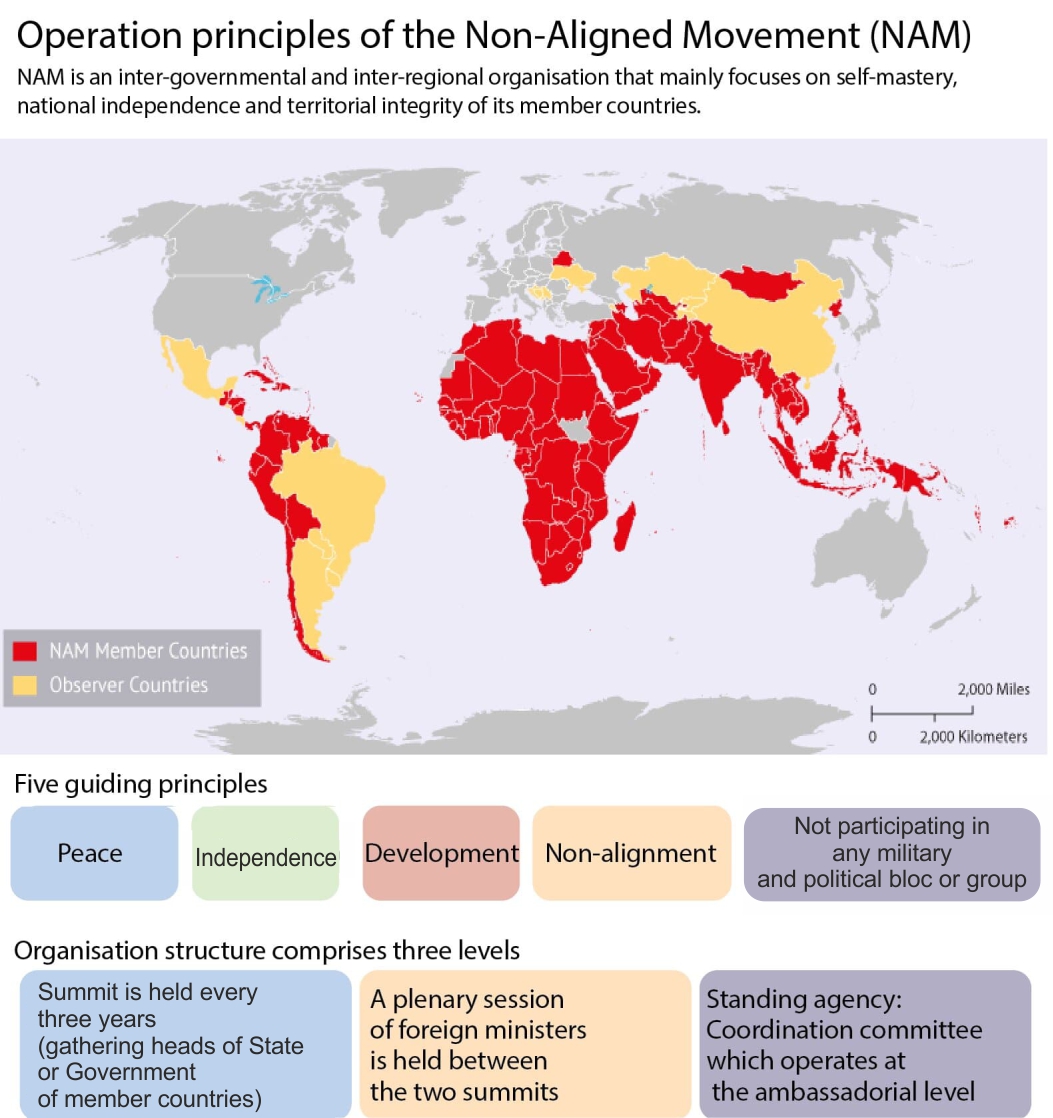International Relations
Revival of Non-Alignment Movement
- 13 May 2020
- 8 min read
This article is based on “What’s in a NAM?” which was published in The Indian Express on 11/05/2020. It talks about the relevance of the Non-Alignment Movement (NAM) in present times.
Recently, the Prime Minister of India hosted a video conference that addresses a summit of the Non-aligned nations. This is in concurrence of India’s efforts of promoting global cooperation in combating the Covid-19 pandemic.
In the domain of foreign policy, this meeting assumes great significance, given the fact that Indian Prime Minister has skipped the last two NAM summits, at Venezuela in 2016 and Azerbaijan in 2019.
It is argued that the Non-Alignment Movement (NAM) was the product of certain circumstances which have undergone a sea change and thus, have become irrelevant.
However, the Covid-19 pandemic and India renewed interest in NAM, have earmarked the relevance of Non-Alignment Movement (NAM) to pursue effective work programmes at the international level.
Why is NAM criticised?
The Non-Aligned Movement was formed during the Cold War as an organization of States that did not seek to formally align themselves with either the superpowers: the United States or the Soviet Union but sought to remain independent or neutral. It also stands united for the decolonization of European colonies in Asia and Africa.
However, the world order has changed significantly in 21st-century, which has rendered the utility of the NAM doubtful:
- The cold war has ended with the disintegration of USSR in 1991 and subsequently:
- The bi-polar world is non-existent.
- The collapse of communism and the communist bloc and thereby ending the ideological rivalry between capitalism vs communism.
- Since the US emerged as the sole world power following the collapse of the Soviet Union, many non-aligned countries left the NAM.
- Shifting of global politics narrative from the balance of power to economic interdependence.
- Decolonisation project has become redundant, as almost all major colonies have been decolonised.
- It is argued that NAM today competes with groups like the Commonwealth. The other groups are more effective, as they deal with economic and trade issues.
- NAM does not do that, nor does it take up any diplomatic initiative.
- It has no position even on issues like human rights, child exploitation and gender issues. Also, most of the members of NAM are developing.
- As a result, its members have to follow the Western dictates in this regard.
Relevance of NAM
The 21st-century world order is significantly different from that of the 20th-century. Though the world has changed, the problems have remained almost the same. In this context, NAM can prove its worth by striving to work for the following contemporary issues:
New Cold War
- Those who say the NAM is a relic of the Cold War must also acknowledge that a new Cold War is beginning to unfold, this time between the US and China.
- This can be reflected in Trade War, Quad initiative, Indo-pacific narrative, emergence of Shanghai Cooperation Organisation, naval presence in the Indian ocean, etc.
The resurgence of colonialism: Neo-colonialism
- Neocolonialism is the practice of using capitalism, globalisation, cultural imperialism, and conditional aid to influence a developing country instead of the previous colonial methods of direct military control (imperialism) or indirect political control (hegemony).
- China’s investment in Africa and Asia through its Belt and Road initiative is criticized for being neo-colonialism in nature whereas NAM can help in establishing the ethos of collective action.
Restructuring and democratization of the UN
- Due to undemocratic representation and veto power of permanent members in UNSC, the UNSC has been criticised as undemocratic. Thus, there has been a demand for reforms in the UN system for long.
Combating Global Issues
- NAM becomes relevant to mobilize international public opinion against terrorism, weapons of mass destruction (WMDs), nuclear proliferation, ecological imbalance, safeguarding interests of developing countries in WTO (World Trade Organization) etc.
Importance of NAM for India
Support for India’s Candidature in UNSC
- NAM’s total strength comprises 120 developing countries and most of them are members of the UN General Assembly.
- Thus, NAM members act as an important group in support of India’s candidature as a permanent member in UNSC.
Global South Cooperation
- India is widely perceived as a leader of the developing world. Thus, India’s engagement with NAM will further help in the rise of India’s stature as the voice of the developing world or global south.
- In times of increasing protectionism, NAM can provide a platform for South-South cooperation.
Strengthening of Multipolar World Order
- A multipolar world order is in concurrence with Indian forigen policy.
- Thus, NAM can help in formation of a multipolar world with India becoming a major pole.
Conclusion
Given the relevance of NAM in present times, it remains a critical diplomatic forum for the pursuit of India’s forign policy interests. Therefore India must refrain from treating NAM as a ritual to be performed every three years and start engaging with NAM constructively.
Thus, just like the start of cold war provided the ground for NAM in the 20th century, the Covid-19 pandemic has provided an opportunity for India to lay the foundation of NAM 2.0. In this context, the virtual NAM summit hosted by India is a step in the right direction.
|
Drishti Mains Question Discuss the relevance of Non-alignment movement in present times. |
This editorial is based on “Ease Land Markets” which was published in The Times of India on May 12th, 2020. Now watch this on our Youtube Channel.







